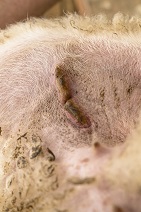Kiss Goodbye to Scabby Mouth:
Scabby mouth is a painful frustrating disease that slows the growth of lambs due to their inability to feed properly. Lambs get infected when the virus is able to penetrate through skin or mucous membranes in the mouth, often because they have been damaged through chewing on something sharp like thistles.
Scabby mouth commonly affects the lips, mouth and surrounding skin, but can also affect the face, feet and the udder of nursing ewes. The virus causes sores which then form a crust before scabbing over and falling off. This cycle takes about 4-5 weeks, but secondary bacterial infections can make lesions worse and extend the healing time.
There is no treatment for Scabby mouth and the disease is generally left to run its course. However, significant losses in production through decreased growth rates occur during this time. In severe cases, additional supportive treatment, such as antibiotic therapy, may be required for the secondary infections. The disease is best managed by prevention. Vaccinating sheep and lambs against the virus can be done effectively with Scabigard® vaccine.
Lambs should be vaccinated as early as possible, with tailing being the most convenient time, before they get infected. On properties where Scabby mouth is a problem, new bought in sheep should also be vaccinated as they may be naive and could be prone to infection. Vaccination should be completed at least 6-8 weeks prior to shearing to reduce the risk of shearers contracting the virus. Care should be taken while vaccinating, as the virus is transmissible to people if the skin is damaged through an inadvertent ‘scratch’!
Scabigard is easily administered by ‘scratching’ the skin of the inside of the thigh or foreleg with the applicator, forming a scratch mark about 5cm long. This produces a controlled form of Scabby mouth at the site of the scratch away from the mouth where it won’t interfere with feeding, while the animal develops immunity. Unlike other vaccines, a check can be made to see if the vaccine has been administered correctly and the animal is mounting an immune response. 10-14 days after the scratch, a sample of 10 sheep should be caught and checked for a ‘take’ (see Fig 1).

Figure 1: Example ‘take’ of Scabigard vaccine
Our best practice administration flyer is available to download below for further information.
Scabigard Administration Flyer
Vaccinated sheep will have long lived immunity against the virus but are usually boosted through natural exposure in the paddocks. In a high viral challenge situation, this may not be completely protective and previously vaccinated (or naturally infected) animals, can get Scabby mouth again, although lesions are usually not as severe and they heal up much more quickly.
For more advice on managing Scabby mouth or Scabigard, talk to your vet, or contact Zoetis.